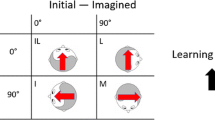Abstract
To represent a stable environment despite the experience of changes during self movements, one can either develop an invariant allocentric representation, or update the egocentric representations as one moves. Using a disorientation paradigm, three sets of studies investigated these mechanisms in human navigation and scene recognition. Accuracy in the configuration of multiple object localization is impaired by disorientation, an effect not due to artifacts such as memory deterioration over time, intervening physical activities, uncertainty in self position and orientation, etc., suggesting one can locate objects primarily by updating their egocentric positions as she or he moves. Disorientation also impaired the judgment of changes to a scene after viewer movements, suggesting a similar egocentric updating process. On the contrary, representation of the shape of the surroundings is invariant and persists through disorientation. The coexistence of multiple mechanisms may increase the flexibility and robustness of the system.
Similar content being viewed by others
References
Acredolo, D., Adams, A. and Goodwyn, S.W. (1984). The Role of Self-Produced Move-ment and Visual Tracking in Infant Spatial Orientation, Journal of Experimental Child Psychology 38: 312–327.
Amorim, M.A., Glasauer, S., Corpinot, K. and Berthoz, A. (1997). Updating an Object's Orientation and Location during Non Visual Navigation: A Comparison between Two Processing Modes, Perception & Psychophysics 59: 404–418.
Benson, J.B. and Uzgiris, I.C. (1985). Effect of Self-Initiated Locomotion on Infant Search Activity, Developmental Psychology 21: 923–931.
Biederman, I. and Gerhardstein, P.C. (1993). Recognizing Depth-Rotated Objects: Evidence and Conditions for Three-Dimensional Viewpoint Invariance, Journal of Experimental Psychology: Human Perception and Performance 19: 1162–1182.
Bridgeman, B., Van der Hejiden, A.H.C. and Velichkovsky, B.M. (1994). A Theory of Visual Stability across Saccadic Eye Movements, Behavioral & Brain Sciences 17: 247–292.
Cheng, K. (1986). A Purely Geometric Module in the Rat's Spatial Representation, Cognition 23: 149–178.
Diwadkar, V.A. and McNamara, T.P. (1997). Viewpoint Dependence in Scene Recognition, Psychological Science 8: 302–307.
Duhamel, J.-R., Colby, D.L. and Goldberg, M.E. (1992). The Updating of the Representation of Visual Space in Parietal Cortex by Intended Eye Movements, Science 255: 90–92.
Easton, R.D. and Sholl M.J. (1995). Object-Array Structure, Frames of Reference, and Retrieval of Spatial Knowledge, Journal of Experimental Psychology: Learning, Memory, and Cognition 21: 483–500.
Farrell, M.J. and Robertson, I.H. (1998). Mental Rotation and the Automatic Updating of Body-Centered Spatial Relationships, Journal of Experimental Psychology: Learning, Memory, and Cognition 24: 227–233.
Fukusima, S.S., Loomis, J.M. and Da Silva, J.A. (1997). Visual Perception of Egocentric Distance as Assessed by Triangulation, Journal of Experimental Psychology: Human Perception and Performance 23: 86–100.
Gallistel, C.R. (1990). The Organization of Learning.Cambridge,MA: MIT Press.
Gibson, J.J. (1979). The Ecological Approach to Visual Perception. Boston: Houghton Mifflin.
Hermer, L. and Spelke, S.S. (1996). Modularity and Development: The Case of Spatial Reorientation, Cognition 61: 195–232.
Huttenlocher, J. and Presson C.C. (1979). The Coding and Transformation of Spatial Information, Cognitive Psychology 11: 375–394.
Irwin, D.E. (1996). Integrating Information across Saccadic Eye Movements, Current Direc-tions in Psychological Science 5: 94–100.
Landau, B., Spelke, E.S. and Gleitman, H. (1984). Spatial Knowledge in a Young Blind Child, Cognition 16: 225–260.
Mittelstaedt, M.L. and Mittelstaedt, H. (1980). Homing by Path Integration in a Mammal, Naturwissenschaften 67: 566–567.
Rieser, J.J. and Rider, E.A. (1991). Young Children's Spatial Orientation with Respect to Multiple Targets when Walking without Vision, Developmental Psychology 27: 97–107.
Rieser, J.J. (1989). Access to Knowledge of Spatial Structure at Novel Points of Observation, Journal of Experimental Psychology: Learning, Memory & Cognition 15: 1157–1165.
Shelton, A.L. and McNamara, T.P. (1997). Multiple Views of Spatial Memory, Psychonomic Bulletin & Review 4: 102–106.
Simons, D.J. and Wang, R.F. (1998). Perceiving Real-World Viewpoint Changes, Psycholo-gical Science 9: 315–320.
Tarr, M.J. (1995). Rotating Objects to Recognize Them: A Case Study on the Role of Viewpoint Dependency in the Recognition of Three-Dimensional Objects, Psychonomic Bulletin & Review 2: 55–82.
Tarr, M.J. and Pinker, S. (1989). Mental Rotation and Orientation-Dependence in Shape Recognition, Cognitive Psychology 21: 233–282.
Tolman, E.C. (1948). Cognitive Maps in Rats and Men, Psychological Review 55: 189–208.
Ullman, S. and Basri, R. (1991). Recognition by Linear-Combinations of Models, IEEE Transactions On Pattern Analysis And Machine Intelligence 13: 992–1006.
Vetter, T., Hurlbert, A. and Poggio, T. (1995). View-Based Models of 3D Object Recognition: Invariance to Imaging Transformations, Cerebral Cortex 5: 261–269.
Wang, R. (1999). Spatial Representations of object Locations and Environment Shape. Thesis (Ph.D.), Massachusetts Institute of Technology.
Wang, R.F. and Simons, D.J. (1999). Active and Passive Scene Recognition across Views, Cognition 70: 191–210.
Wang, R.F. and Spelke, E.S. (2000). Updating Egocentric Representations in Human Navigation, Cognition 77: 215–250.
Wang, R.F., Hermer, L. and Spelke, E.S. (1999). Mechanisms of Reorientation and Object Localization by Human Children: A Comparison with Rats, Behavioral Neuroscience 113: 1–11.
Wehner R. and Srinivasan M.V. (1981). Searching Behavior of Desert Ants, Genus Cataglyphis (Formicidae, Hymenoptera), Journal of comparative Physiology 142: 315–318.
Author information
Authors and Affiliations
Rights and permissions
About this article
Cite this article
Wang, R.F. Representing a stable environment by egocentric updating and invariant representations. Spatial Cognition and Computation 1, 431–445 (1999). https://doi.org/10.1023/A:1010043814328
Issue Date:
DOI: https://doi.org/10.1023/A:1010043814328




